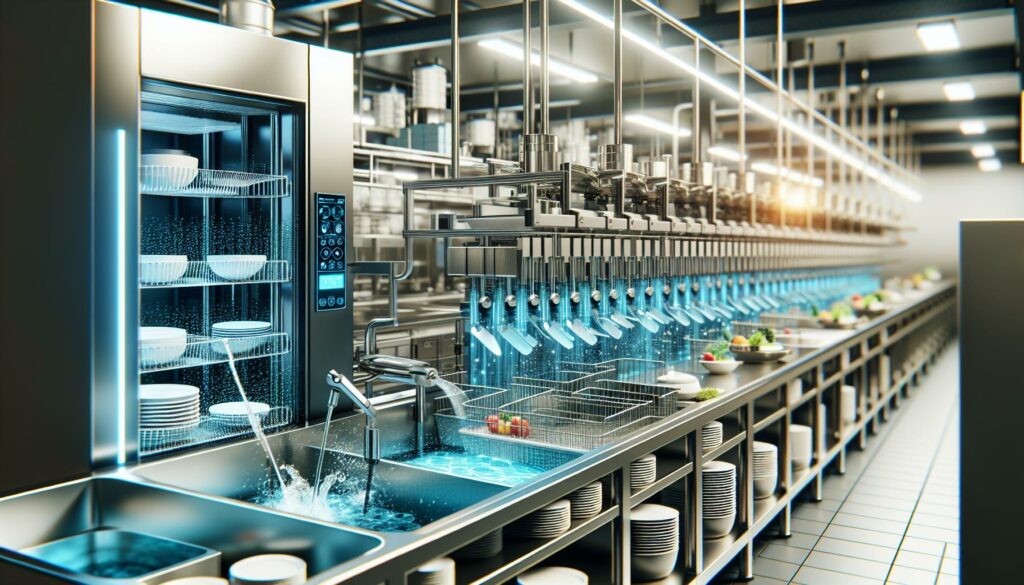In today’s fast-paced world, efficiency is key, especially in the food service industry. That’s where Dishcraft Robotics steps in, revolutionizing how we handle dishwashing and sanitation. By integrating cutting-edge robotics with artificial intelligence, Dishcraft is not just automating a tedious task; it’s redefining operational standards for restaurants and commercial kitchens.
I’ve seen firsthand how this technology can transform workflows, allowing staff to focus on what they do best—creating delicious dishes and providing exceptional service. With Dishcraft’s innovative approach, the future of kitchen operations looks cleaner and more efficient than ever. Let’s dive into how this remarkable company is changing the game in food service.
Key Takeaways
- Revolutionizing Dishwashing: Dishcraft Robotics utilizes advanced robotics and AI to automate dishwashing processes, significantly improving efficiency in food service operations.
- Time Savings: Restaurants can reduce dishwashing time by up to 70%, allowing staff to prioritize food preparation and customer service, leading to enhanced dining experiences.
- Environmental Benefits: The technology minimizes water and energy consumption, employing eco-friendly detergents and helping businesses promote sustainability while reducing operational costs.
- Adaptability: Dishcraft’s machine learning algorithms refine washing protocols in real-time, adjusting for varying dish types and kitchen traffic, ensuring consistent cleaning results.
- Integration Challenges: While the initial investment for Dishcraft Robotics can be high, long-term savings and potential financing options make it a viable choice for many establishments.
- Maintenance Importance: Regular maintenance and support are essential for optimal system performance, and establishing partnerships for servicing can enhance the reliability of robotic systems in commercial kitchens.
Dishcraft Robotics
Dishcraft Robotics focuses on revolutionizing the dishwashing process in the food service industry. By utilizing advanced robotics and artificial intelligence, Dishcraft automates tedious dishwashing tasks while ensuring high standards of cleanliness. This technology integrates seamlessly into restaurant operations, reducing labor costs and increasing efficiency.
Dishcraft’s robotic systems consist of multiple components, including sorting machines, automated washing stations, and drying units. Each component works in harmony to optimize the workflow. For example, the sorting machine quickly separates clean from dirty dishes, minimizing human handling and potential contamination.
The software underlying Dishcraft’s technology leverages machine learning to adapt and refine washing protocols. It analyzes patterns in dish types and volumes, adjusting for peak hours and varying service demands. This adaptability leads to enhanced efficiency and a consistent washing outcome regardless of kitchen traffic.
Utilizing Dishcraft Robotics results in measurable benefits. Restaurants can observe reduced dishwashing time by up to 70%. This reduction allows staff to focus more on food preparation and customer interactions. As a result, operations become smoother and more productive, paving the way for improved service quality in commercial kitchens.
Technology Behind Dishcraft Robotics
Dishcraft Robotics employs cutting-edge technology to modernize dishwashing in the food service industry. This section dives into the specifics of their automated processes and the integration of robotics and AI.
Automated Dishwashing Process
Dishcraft’s automated dishwashing process consists of several critical stages. First, the sorting machines receive dirty dishes, automatically identifying material types and preparing them for washing. Next, the dishes move to automated washing stations where precision jets remove food residues, using specialized detergents that comply with hygiene standards. After washing, drying units ensure dishes are free from moisture, completing the cycle efficiently. This meticulously designed workflow not only meets stringent cleanliness requirements but also reduces human errors, ensuring consistent results across numerous service demands.
Robotics and AI Integration
Dishcraft Robotics incorporates advanced robotics and artificial intelligence to enhance operational efficiency. The robotic systems leverage AI-driven software that analyzes incoming data to optimize washing protocols based on factors such as dish types and volume. Machine learning algorithms adapt the processes in real-time, refining techniques based on performance metrics, which improves efficiency and reduces wash times. The synergy between robotics and AI allows for seamless management of dishwashing workloads, facilitating a more streamlined kitchen experience and enabling staff to focus on food preparation and customer service.
Benefits of Dishcraft Robotics
Dishcraft Robotics offers numerous advantages that significantly enhance operations in the food service industry. Its integration leads to improved efficiency, cost savings, and environmental benefits.
Efficiency and Time Savings
Dishcraft Robotics reduces dishwashing time by up to 70%, transforming kitchen workflows. This automation allows staff to focus on food preparation and customer service, ultimately elevating the dining experience. Automated systems streamline processes such as sorting and washing, ensuring that dishes are cleaned and dried quickly. As a result, restaurants experience faster table turnover rates, increased productivity, and the ability to serve more customers efficiently.
Environmental Impact
Dishcraft Robotics contributes to environmental sustainability through reduced water and energy usage. Automated washing stations optimize water consumption, using only what is necessary for effective cleaning. The technology also employs eco-friendly detergents that minimize harmful environmental effects. By lowering resource consumption, Dishcraft Robotics not only supports green initiatives in commercial kitchens but also helps businesses reduce their operational costs while promoting a sustainable future.
Use Cases and Applications
Dishcraft Robotics significantly enhances efficiency across various settings, especially in restaurants, cafeterias, and even home kitchens. Its applications demonstrate how automation and AI transform dishwashing tasks.
Restaurants and Cafeterias
Dishcraft Robotics optimizes operations in restaurants and cafeterias by streamlining dishwashing processes. Automated systems significantly reduce labor costs while increasing throughput. Sorting machines rapidly identify and classify dish materials, ensuring they reach the right washing unit. Automated washing stations, equipped with precision jets, clean dishes efficiently using eco-friendly detergents. This process leads to a 70% reduction in dishwashing time, allowing staff to focus on food preparation and customer service, elevating the dining experience. By minimizing manual labor, kitchens operate more smoothly, leading to improved workflows and enhanced cleanliness standards.
Home Kitchens
Dishcraft Robotics also finds a place in home kitchens, providing families with convenient dishwashing solutions. Although primarily designed for commercial use, the technology can adapt to residential settings, optimizing water and energy consumption. Homeowners benefit from time savings, reducing the burden of post-meal cleanup. Robotic systems designed for homes can feature compact designs while maintaining high efficiency, ensuring cleanliness with less effort. The integration of smart technology allows these systems to adapt to specific dish types and volume, further enhancing user experience.
Challenges and Considerations
Integrating Dishcraft Robotics involves addressing various challenges and considerations. Understanding these factors ensures a smoother transition and implementation within commercial kitchens and residential settings.
Cost and Accessibility
Cost plays a significant role in the adoption of Dishcraft Robotics. Initial investments can be substantial, depending on the scale of the operation and specific needs. Systems may range from $50,000 to $250,000, influenced by features and capabilities. While these expenses represent a barrier for some businesses, the long-term savings in labor and operational efficiency often justify the investment. Accessibility also presents challenges, particularly for smaller establishments. Comprehensive financing options and phased implementation plans can aid in overcoming budget constraints, making advanced robotic systems more attainable for a wider array of users.
Maintenance and Support
Maintenance and support are crucial for sustaining operational efficiency in automated systems. Regular maintenance ensures optimal performance and reliability, reducing downtime. Dishcraft Robotics recommends a maintenance schedule that includes weekly inspections and quarterly service checks. Support availability from manufacturers also influences user experience. Effective customer service channels, including remote assistance and on-site support, enhance operational resilience. Establishing partnerships with service providers can alleviate maintenance burdens and ensure ongoing functionality of robotics systems in busy kitchen environments.
Transforming the Food Service Industry
Dishcraft Robotics is truly transforming the food service industry. By automating dishwashing tasks, it frees up valuable time for kitchen staff to focus on what they do best—cooking and serving customers.
The integration of advanced robotics and AI not only enhances operational efficiency but also promotes sustainability in commercial kitchens. With significant time savings and cost reductions, restaurants can elevate their service quality while maintaining high cleanliness standards.
As I see it, embracing this technology isn’t just about keeping up with trends; it’s about setting new benchmarks for efficiency and sustainability in the culinary world. The future of dishwashing is here, and it’s revolutionizing how we think about kitchen operations.

